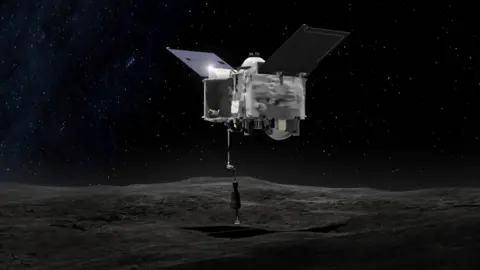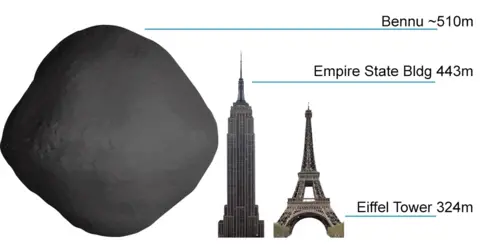Osiris-Rex: Nasa probe arrives at Asteroid Bennu
 NASA/University of Arizona
NASA/University of ArizonaThe American space agency's Osiris-Rex probe has drawn up alongside Asteroid Bennu after a two-year, two-billion-km journey from Earth.
The mission will spend 2.5 years at the 500m-wide rock, mapping its surface and studying its composition.
In mid-2020, scientists will direct Osiris-Rex to drop down to the object and grab at least 60g of regolith, or "top soil".
This will be packed away in a sterile capsule to be returned home in 2023.
 NASA
NASAControllers commanded the robotic probe on Monday to fire its thrusters for 20 seconds.
This enabled Osiris-Rex to match Bennu's velocity through space, and bring it to about 20km from the rock at closest approach.
Heather Enos, the Osiris-Rex deputy principal investigator, was in the spacecraft manufacturer Lockheed Martin's control room in Littleton, Colorado, when completion of the thruster burn was confirmed.
"My heart-rate is three times faster than normal but I'm super-excited. Watching the team celebrate such an amazing milestone brings personal joy to me in so many ways I can't even explain," the University of Arizona, Tucson, researcher said.
In the coming days, Osiris-Rex will get a little closer to begin its preliminary survey.
"We're going to go over the North Pole three times, then over the equator and the South Pole," explained flight navigator Coralie Adam.
"That allows us to not only estimate the mass, the gravity, of Bennu, which will help us design our future orbits downstream; but it also allows us to map the whole surface and build landmarks that we're going to use to navigate once we get into orbit."
Bennu will become the smallest object ever orbited by a probe. This should occur in the New Year.
Operating in such a limited gravity field will be a challenge for the probe, and its navigators back on Earth.
Just the heat of the Sun on the side of the spacecraft will cause the probe to emit thermal energy that will change its trajectory ever so slightly, but enough that it must be factored into controllers' calculations as they plan manoeuvres.
Allow X content?
Asteroids are left-overs from the original building blocks of the Solar System. As such, they should still retain clues to the events that brought the Sun and the planets into being.
Engineers have developed a collection device for Osiris-Rex that will extend on a robotic arm and "high five" the surface of Bennu.
On contact, this mechanism will deliver a burst of gas to kick up loose fragments that should then settle in a holding chamber prior to being packed away in the return capsule.
"Other probes have brought back samples, for example... the Hayabusa mission from Japan brought back a small sample from its asteroid. But ours will be by far the largest sample collection by a robotic spacecraft," explained Nasa project manager Rich Burns. Possibly up to 2kg if the retrieval system works well.
Not since Apollo at the Moon has so great a mass of material been retrieved from another planetary body.
"We've been slowly creeping up to Bennu and in that time we've been taking the opportunity to snap images... and it's really given us an opportunity to have a sneak peek of what we're about to embark on," said Dr Enos.
"We can see the surface has a lot of boulders, craters - a lot of diversity. So, it's been really exciting. We're also getting images which are giving us insight to potential sample sites that we will start to explore more thoroughly over the next year and a half."
Preliminary scientific findings from the approach images are due to be released at next week's American Geophysical Union (AGU) meeting in Washington DC.

Osiris-Rex - Mission to Asteroid Bennu
 NASA
NASA- It's been a two-year journey to Bennu, arriving 3 December 2018
- After a period of mapping, sampling should occur in July 2020
- Osiris-Rex will have up to three attempts to grab surface material
- The probe will leave Bennu most likely in March 2021
- Its sample capsule should land on Earth on 24 September 2023

[email protected] and follow me on Twitter: @BBCAmos
